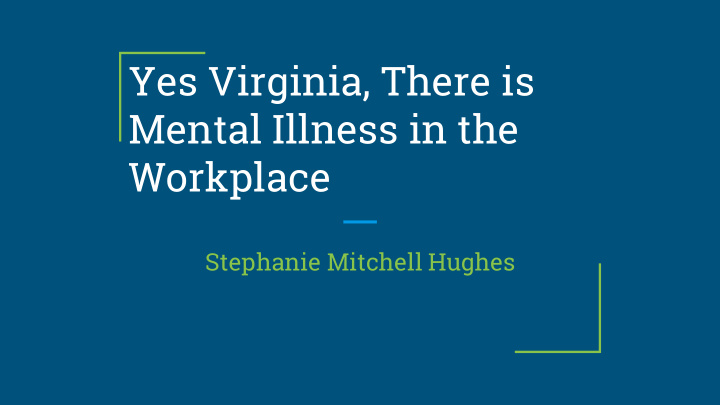



Yes Virginia, There is Mental Illness in the Workplace Stephanie Mitchell Hughes
What is a Mental Illness? The National Alliance on Mental Illness, hereinafter NAMI, defines “mental illness as a condition that affects a person's thinking, feeling or mood. ” These conditions can affect an individual’s ability to relate to others and function each day. They include schizophrenia, anxiety disorders, depression, and bipolar disorder. This presentation will focus on depression.
In the United States perceptions about mental illness and mental health are evolving. Almost 90% of Americans surveyed as part of a Harris Poll value physical and mental health equally.
The Real Question is…. The question is not whether an employer will have to address mental illness within the workplace. There are individuals living with depression and other mental illnesses who successfully perform high pressure and demanding jobs at every level of the organizational paradigm. The question is HOW employers will address and support mental health and well- being in the workplace.
FACT According to the World Health Organization, depression is a common illness that affects roughly 350 million people worldwide.
FACT An analysis conducted by the World Health Organization estimates that by 2030, the world will have lost 12 billion workdays due to depression and anxiety disorders which equals 50 million years of work and an annual loss to the global economy of $925 billion dollars. The impact of mental illness within the workplace has serious consequences for both the employee and employer. Employee performance, rates of illness, absenteeism, accidents and attrition are all affected by an employee’s mental health.
FACT Depression is one of the costliest illnesses affecting workplaces in the United States. A survey of employee assistance professionals ranks depression amongst the top three workplace challenges for employee assistance professionals followed only by family crisis and stress.
FACT Roughly 6.7 percent or 14.8 million American adults are living with depression. The Centers for Disease Control estimate that depression causes 200 million lost work days at an annual cost to employers of between 17 and 44 billion dollars. The World Health Organization approximates that by 2020, depression will be the second leading cause of disability around the world.
WHAT IS A DEPRESSIVE EPISODE? A depressive episode can be mild, moderate, or severe and categorized as recurrent depressive or bipolar disorder.
According to the Centers for Disease Control depression is influenced by a number of factors including: genetics neurotransmitters personality gender physical environment social support systems
SYMPTOMS OF DEPRESSION Symptoms of depression CAN include: persistent sadness or anxiety fatigue impaired judgment or decision making restlessness or irritability lost productivity being passive or withdrawn.
Caveat An employee who manifests these symptoms does not necessarily have depression or any other mental illness. According to the Harvard Mental Health Newsletter symptoms of depression are stealth and often manifest differently in the workplace than at home.
GOOD NEWS! Depression is treatable. According to the World Health Organization, long-term studies show that with treatment most people with depression demonstrate genuine improvement and lead stable, productive lives.
WHAT DOES A SMART EMPLOYER DO? Smart employers support employees living with depression by addressing barriers and foster an environment that values mental health and physical well-being.
Barriers to addressing depression in the workplace include: Toxic workplace culture Restrictive leave and attendance policies Trust and high levels of mistrust Fear, stigma, and shame Inadequate mental health insurance Scarcity of mental health practitioners who manage medications
Ten things that a smart employer does to foster an environment that values mental health and physical well-being. Understands that employee productivity is inextricably Addresses obstacles that prevent employees from securing and then participating in mental health treatment. linked to physical and mental health and well-being. Understands that treatment for depression and other mental illnesses is not a fix-it-and-forget-it solution. It is an ongoing, Acknowledges that there are employees living with complex, and individualized process that is often rife with depression and other mental illnesses working at every overwhelming obstacles. level of the organization. Recognizes the criticality of early intervention and treatment Publicly recognizes and commits to the mental health and for an employee who is having a mental health crisis. well-being of all employees particularly those living with Thinks and plans strategically to reintegrate an employee a mental illness. returning to work after a mental health crisis. Is not biased against an employee simply because he or she Regularly assesses and addresses organizational health lives with depression or another mental illness. and well-being. This includes integrating employee assistance staff into the assessment process. Seeks input from legal counsel BEFORE implementing any policies, strategies, and programs.
PONDER THIS THOUGHT: How am I supposed to sleep when all I can think about is how I don’t want to wake up ?
CONCLUSION So, yes Virginia there is mental illness in the workplace. It is imperative that employers acknowledge that there are courageous employees reporting for work daily wearing the burdensome mantle of mental illness. You have made a substantial investment in training and developing these same men and women. Protect your investment by public announcing your support, working with stakeholders to remove barriers, and fostering a work environment that values mental wellness. Your commitment to mental wellness will yield higher productivity, decreased absenteeism, lower rates of attrition, and increased satisfaction with work.
Sources Depression Fact Sheet , World Health Organization Road to Recovery, Employment and Mental Illness , NAMI High Pressure Jobs and Mental Illness , Diane Coutu, Harvard Business Review Understanding Depression , Harvard Health Publications Mental Health and Work: Impact, Issues, and Good Practices , World Health Organization Mental Health Problems in the Workplace , Harvard Health Why Mental Health Programs in the Workplace are Good for Publications Business , Erin McGinty, Employee Benefits News Mental Illness Facts and Numbers , NAMI The Real Reasons Employees Hide Mental Illness , Indigo Triplett, Workplace Health Promotion: Depression , Centers for Disease Inc. Magazine Control
Recommend
More recommend